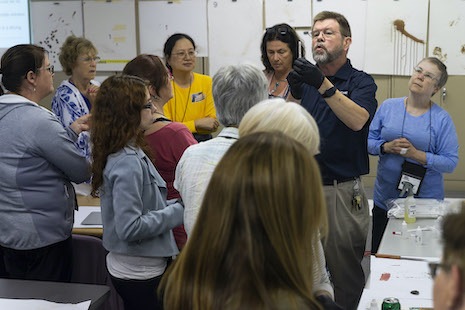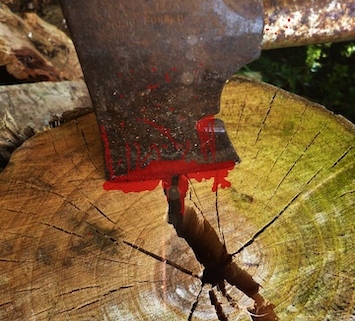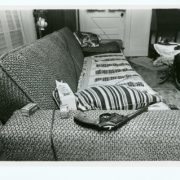An Ax Murder and the Q-Tips: A True Story From My Files
Working as a sheriff’s deputy in the patrol division often presents a few unique challenges as opposed to patrolling city streets, such as having lots of miles to cover when responding to various emergencies.
Other issues faced by law enforcement officers who work in rural settings may include dodging roadway hazards such as large, slow-moving farm equipment, loose cows, deer leaping into the path of patrol cars that’re traveling at warp speeds, patches of slippery ice and, at night, the “Popeye” drivers whose cars and pickup trucks have only one working headlight that somehow seems to always remain on the high beam setting.
 Popeye – nickname assigned to a car having only one functioning headlight. Named after the squinting, spinach-eating cartoon sailor. Toot, toot.
Popeye – nickname assigned to a car having only one functioning headlight. Named after the squinting, spinach-eating cartoon sailor. Toot, toot.
“THAT” Day
I and a fellow deputy began our shift at 0800 that Saturday, and we’d decided to catch up on a bit of paperwork at the office before going our separate ways, making ourselves seen throughout the county. Nothing much happened before noon on Saturdays and that’s why, along with one deputy out sick and another on vacation, there were only two of assigned to work the roads and answer complaints.
It was 0930 when a man called the dispatcher to say he’d just killed his sister-in-law and that the “911 lady” should send “the Po-leece” right away. Then he hung up.
Q-Tips
After receiving the necessary information—location, weapon involved, male suspect—my co-worker and I dropped what we were doing and sprinted to our patrol cars. We left the parking lot with red and blue lights winking, spinning, and blinking and our tires churning up small blackish-blue clouds that reeked of burned rubber.
Throughout the city streets we blasted our sirens at intersections, and when we drove up behind the Saturday morning, slow-moving Q-tips who were on their weekly treks to town.
The “Q-tips,” bless their hearts, are the folks of a certain age. They’re the elderly women who’re on the way to get their hair styled and molded into those blueish-white helmet shapes, and their frail and rickety spouses who stop in the barbershops for a snip here and there and to have the barber apply enough smell-good tonic to keep the snow-white wispy combovers in place while they visit the feed store to browse through the rows of shiny red or green mowers and tractors.
Then, when the appropriate amount of time passes, the tractor-lookers toss their wooden canes into the backseats of their Ramblers or Buicks and head back over to Betty’s Cut and Curl or Donna’s Dipsy-Dos to pick up the wife so together they can do their grocery shopping and perhaps have a bite to eat at the Connie’s Country Diner before traveling at a snail’s pace back to the family farm.
They, the Q-Tips, are the slow drivers who never, not ever, look into their rearview mirrors. Their windows are up to prevent the wind from mussing a new “do,” or blowing the ball cap from old man Johnson’s freshly-slickered eighteen remaining hairs.
So we’d follow behind those rolling boxes of cotton swabs with full lights and sirens until we caught a break in traffic so we could pass.

White-haired retirees are sometimes referred to as Q-tips by traffic officers. This is so because a grouping of them stacked together in a sedan loosely resemble a box of cotton swabs.
That particular Saturday morning, while kids watched cartoons and the mall parking lots began to see the first cars of the day entering their lots, we were pushing the limit, zipping through the city until we reached the main county road that led us in the direction of the alleged murder. The location was 30-40 minutes away when driving the posted speed limit. We reached scene in less than 20. As the truckers’ used to say, it was pedal to the metal all the way. We straightened curves by taking advantage of “the racing line” of the roadway.
For those of you who don’t know, a driver who follows a racing line greatly reduces the angle of a curve by entering it at a the far outside edge of the roadway and then crosses over to the inside edge, the apex. The apex is the point at which you are closest to the inside of the corner. The turn/curve is then completed by moving back to far outside edge of the roadway. This maneuver is sometimes called “hitting the apexes.” Following this tactic reduces braking and “straightens the curve” which allows the officer to drive safely through even deep bends in the roadway at a much faster speed. However, it is a must to constantly remain alert for oncoming traffic, tractors, deer, cows, people on bicycles and motorcycles who sometimes ride three and four wide. Watching out for unexpected obstacle is a must because a bit of the officers’ curve-straightening involves driving on the opposite/wrong side of the road.
The Suspect From Mars
Standing beside a mailbox at the end of a long dirt drive was a man dressed in a red and white striped shirt, white pants, and brown work boots. As we turned into the driveway I noticed what appeared to be a significant amount of blood spatter on his clothing and shoes, so I stopped. He was obviously agitated, excited, and he rambled on incessantly about that fact that he’d just arrived to earth from Mars. I handcuffed him, placed him in the seat beside me (we didn’t have rear cages/compartments back in the day), and hurried to the house.
My coworker and I raced to the door and went inside, yelling “Sheriff’s Department!”
What we found in the home, in the master bedroom, was nothing short of the stuff horror movies are made of.
Blood oozed down the painted drywall in narrow but rapidly drying convoluted trails. Spatter of various sizes and shapes was everywhere—ceiling, walls, the floor. A severed human hand lay next to one wall. I’d later count 13 chop marks in the hardwood next to it. Pools of rusty-red blood separated by drag marks of the same color and substance led to the body of a dead woman, a female who died a brutal death caused by the repeated blows of an ax.
The woman’s forearms were badly cut, signs that she’d attempted to stop dozens of strikes of the ax. A large gash to the right side of her head revealed the white of her skull, bone that had been hacked and chipped away, revealing brain matter. Some of it was found stuck to the ceiling.
Small bits of splintered bone lay scattered across the floor.
Blood spatter found its way to the bedroom furniture, including a king-size bed where its dull brownish-red hue was in sharp contrast to the crisp white sheets. More spatter peppered the faces, hands, legs, and feet of the woman’s four small children who sat huddled together on the center of the mattress. It looked like a random splattering of freckles across their skin. The Winnie the Pooh and Scooby Do cartoon characters that decorated the kids’ pajamas each wore dozens of bloody dots of brownish dry blood along with larger cast-off stains.
Those tiny boys and girls witnessed the entire act. They watched the killing of their mother that occurred for the simple reason that the perpetrator had asked his sister-in-law for enough money to purchase a pack of cigarettes and she didn’t have it. So the man, their “blood” uncle, walked outside to the woodpile where he picked up the ax and went back inside to kill.
The first blow was from behind, to the head. She went down but turned and held up her arms and hands to fend off the onslaught that followed. But there was little she could do once he went to work on her, chop after chop.
When I questioned the killer he claimed to have come to Earth from Mars and that voices from a nearby power-line tower told him to kill the woman. He also said he’d cut off her hand because the fingers kept pointing at him.
He’d been tucked away in a psychiatric care hospital until two weeks prior to the murder. His release came when a sympathetic judge found him competent to return to life outside, placing him in the care of his brother. Fourteen days later the brother’s wife was dead and his four kids were scarred for life.
The killer was found to be not competent to stand trial for the murder and has remained in a psychiatric facility since.
The Art of Blood
 To learn how investigators interpret blood evidence, sign up today to attend retired FBI Special Agent David Alford’s hands-on MurderCon class, The Art of Blood.
To learn how investigators interpret blood evidence, sign up today to attend retired FBI Special Agent David Alford’s hands-on MurderCon class, The Art of Blood.
Special Agent Alford is a retired FBI Special Agent with 21 years of experience investigating violent crimes, terrorism and other cases. He was one of the founding members of the FBI Evidence Response Team (ERT) and conducted crimes scene searches on domestic and international violent crimes and bombings, including the Polly Klaas kidnaping and murder, the Unabomber’s cabin and the 9/11 Pentagon scene. He worked in the Denver and San Francisco field offices and completed his career at Quantico in the FBI Lab ERT Unit. During the 6 years in the FBI Lab, he was primarily responsible for overseeing and teaching basic and advanced crime scene courses throughout the US and many other countries.
In the 6 years before the FBI, David was a Forensic Serologist, Hair and Fibers Examiner and Bloodstain Pattern Analyst for the Kentucky State Police Crime Lab. After retirement, David taught crime scene courses around the world on behalf of the FBI and US State Department. David has been with Sirchie as an instructor and sales representative for Sirchie’s RUVIS and ALS products for the last 10 years. David loves teaching and allowing students to learn through hands-on training.

FBI Special Agent (ret.) David Alford, Sirchie/MurderCon instructor.
Violent crimes and accidents frequently involve the interpretation of blood evidence. This class offers the attendee the opportunity to learn how to determine the velocity and angle in which a bloodstain impacted a surface, and the 3-dimensional point of origin – where injury or bleeding event occurred. The instruction will include presumptive testing techniques of stains thought to be blood, as well as, searching crime scenes for latent blood with luminol when circumstances dictate that the area was cleaned by the perpetrator. Attendees will participate in hands-on activities to reinforce the learning objectives.
MurderCon!
There’s still time to attend MurderCon, an event featuring hands-on workshops that are typically for law enforcement eyes ONLY!

To view MurderCon classes and workshops click HERE.
To sign up to attend this unique event for writers, readers, fans, and anyone who’s interested in attending actual hands-on law enforcement training at a renowned facility, click HERE.








